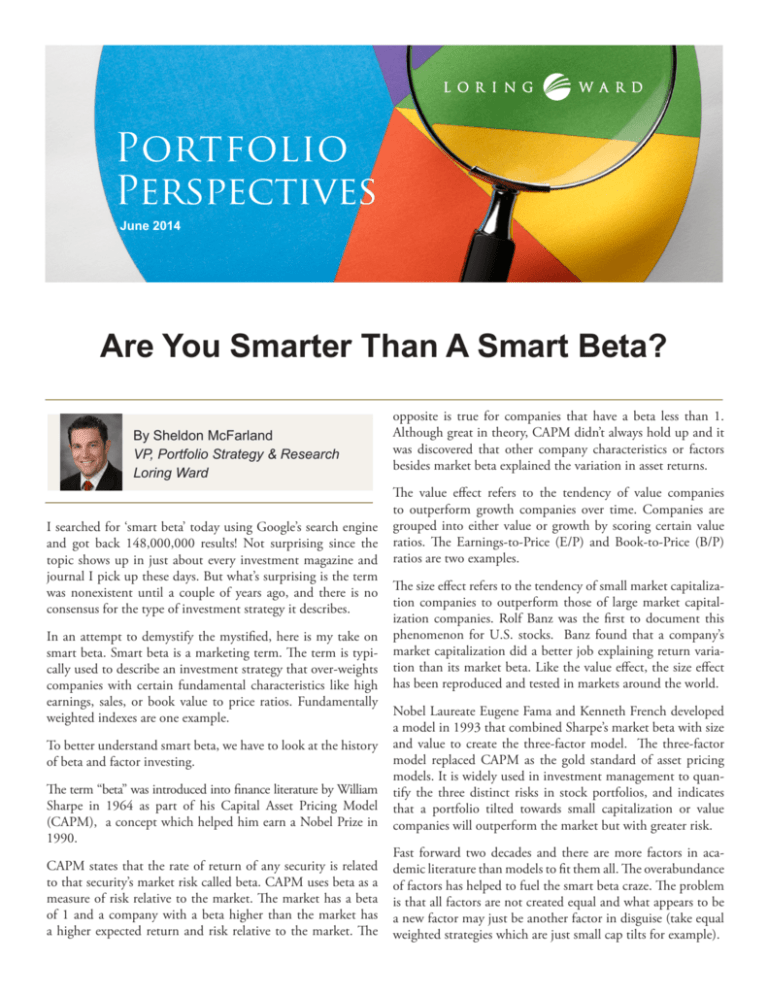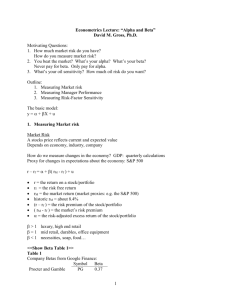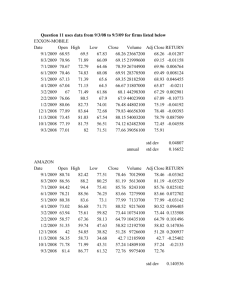
Portfolio
Perspectives
June 2014
Are You Smarter Than A Smart Beta?
By Sheldon McFarland
VP, Portfolio Strategy & Research
Loring Ward
I searched for ‘smart beta’ today using Google’s search engine
and got back 148,000,000 results! Not surprising since the
topic shows up in just about every investment magazine and
journal I pick up these days. But what’s surprising is the term
was nonexistent until a couple of years ago, and there is no
consensus for the type of investment strategy it describes.
In an attempt to demystify the mystified, here is my take on
smart beta. Smart beta is a marketing term. The term is typically used to describe an investment strategy that over-weights
companies with certain fundamental characteristics like high
earnings, sales, or book value to price ratios. Fundamentally
weighted indexes are one example.
To better understand smart beta, we have to look at the history
of beta and factor investing.
The term “beta” was introduced into finance literature by William
Sharpe in 1964 as part of his Capital Asset Pricing Model
(CAPM), a concept which helped him earn a Nobel Prize in
1990.
CAPM states that the rate of return of any security is related
to that security’s market risk called beta. CAPM uses beta as a
measure of risk relative to the market. The market has a beta
of 1 and a company with a beta higher than the market has
a higher expected return and risk relative to the market. The
opposite is true for companies that have a beta less than 1.
Although great in theory, CAPM didn’t always hold up and it
was discovered that other company characteristics or factors
besides market beta explained the variation in asset returns.
The value effect refers to the tendency of value companies
to outperform growth companies over time. Companies are
grouped into either value or growth by scoring certain value
ratios. The Earnings-to-Price (E/P) and Book-to-Price (B/P)
ratios are two examples.
The size effect refers to the tendency of small market capitalization companies to outperform those of large market capitalization companies. Rolf Banz was the first to document this
phenomenon for U.S. stocks. Banz found that a company’s
market capitalization did a better job explaining return variation than its market beta. Like the value effect, the size effect
has been reproduced and tested in markets around the world.
Nobel Laureate Eugene Fama and Kenneth French developed
a model in 1993 that combined Sharpe’s market beta with size
and value to create the three-factor model. The three-factor
model replaced CAPM as the gold standard of asset pricing
models. It is widely used in investment management to quantify the three distinct risks in stock portfolios, and indicates
that a portfolio tilted towards small capitalization or value
companies will outperform the market but with greater risk.
Fast forward two decades and there are more factors in academic literature than models to fit them all. The overabundance
of factors has helped to fuel the smart beta craze. The problem
is that all factors are not created equal and what appears to be
a new factor may just be another factor in disguise (take equal
weighted strategies which are just small cap tilts for example).
Portfolio Perspectives
A downfall of many of the available smart beta strategies is that
they are simulated in laboratories and may not work well in the
real world, where trading costs, taxes, and investor behavior,
impact real world returns. Science can only get you so far —
you also have to consider how science works in the real world.
Smart beta is just a new term for what others have been doing
for years. For almost 25 years, we’ve been fortunate to work
with Dimensional Fund Advisors, who pioneered factor-based
investing more than 30 years ago with their small cap and value
strategies.
The Fama/French factors may not be the final word. Momentum
is gaining favor as a factor with academics and practitioners but
they debate its real-world implications. And a working paper
posted by Fama and French on the Social Science Research
Network explores profitability and investment as two new
factors. The availability of factors makes an investment manager’s job much more difficult because combining more factors
doesn’t necessarily add value to the investment process. Knowing which factors to use and which not to use in the real world
is important to adding value.
The strategy has survived and thrived in the real world testing
of the last 20 years. Before you get caught up in the smart beta
craze, ask yourself does the strategy reflect how people invest
and can it stand up against rigorous, scientific testing across
markets and time?
1
Sharpe, W. 1964. Capital Asset Prices: A Theory of Market Equilibrium Under Conditions of Risk, Journal of Finance 19, 425-442.
2
Banz, R. 1981. The Relationship between Return and Market Value of Common Stock, Journal of Financial Economics 9, 3-18.
3
Hawawini, G., and D. Keim. 2000. The Cross Section of Common Stock Returns: A Review of the Evidence and Some New Findings, in Keim, D.B. and W.T.
Ziemba, Security Market Imperfections in Worldwide Equity Markets (Cambridge University Press, 2000).
4
Fama, E. and K. French. 1993. Common Risk Factors in the Returns of Stocks and Bonds, Journal of Financial Economics 33, 3-56.
All investments involve risk, including the loss of principal and cannot be guaranteed against loss by a bank, custodian, or any other financial institution.
Stock investing involves risks, including increased volatility (up and down movement in the value of your assets) and loss of principal.
The risks associated with investing in stocks and overweighting small company and value stocks potentially include increased volatility (up and down movement
in the value of your assets) and loss of principal.
© 2014 LWI Financial Inc. All rights reserved.
LWI Financial Inc. (“Loring Ward”) is an investment adviser registered with the Securities and Exchange Commission. Securities transactions are offered
through its affiliate, Loring Ward Securities Inc., member FINRA/SIPC. IRN R 14-245 (Exp 5/16)









